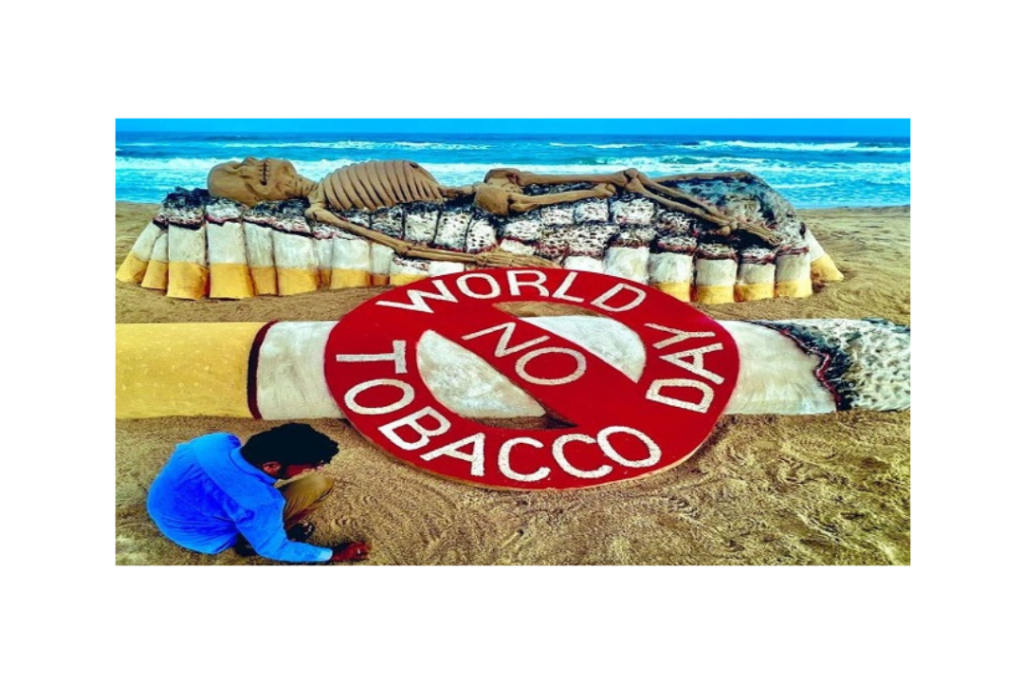The global health crisis is greatly threatened by the pervasive hazard of tobacco use. Tobacco causes terrible harm to the human body whether it is smoked, chewed, or vaped, with lung cancer being the most dangerous effect. The goal of World No Tobacco Day, also known as Anti-Tobacco Day, is to raise awareness of the dangers of tobacco use on May 31st of each year.
Table of Contents

Smoking
The most common way that tobacco is consumed is through smoking, which includes using pipes, cigars, and cigarettes. Each entails breathing in harmful smoke into the lungs.
Chewing Tobacco
Snuff and chewing products are often mistaken for safer substitutes. On the other hand, they do serve as potent triggers for major health issues including oral cancer.
E-Cigarettes and Vaping
Vaping devices and e-cigarettes release nicotine and other toxic substances, despite being touted as less risky. This poses a serious risk to health.
Health Risks Associated
Use incurs both immediate and protracted detriments to health. The use has short-term and long-term negative effects on health.
Immediate Effects on the Body
From the first instant of exposure, tobacco causes harm. From the first instant of exposure, tobacco causes harm. The adrenaline rush that nicotine produces increases heart rate and blood pressure. Breathing becomes harder and lung capacity is reduced.
Long-Term Health Consequences
Chronic diseases are caused by long-term consumption. Smoke tar coats the lungs and causes respiratory illnesses, while tobacco’s compounds assault the cardiovascular system and raise the risk of heart disease.
The Biggest Risk Lung Cancer
Statistics on Lung Cancer
The leading cause of cancer-related death worldwide is lung cancer, and most occurrences are related to smoking. The risk of developing lung cancer is significantly higher in smokers than in non-smokers.
How Tobacco Causes Lung Cancer
There are more than 70 recognized carcinogens in tobacco smoke. Over time, these poisons cause malignant changes in lung cells by ravaging them. The chance of developing lung cancer is increased by the amount and duration of smoking.
Other Types of Cancer Linked
In addition to lung cancer, use is a known cause of several other cancers.
Mouth Cancer
Consumption, both smoked and chewed, can result in cancers of the oral cavity, affecting the lips, tongue, and gums.
Throat and Larynx Cancer
Because harmful smoke directly passes through the throat and larynx, smoking increases the risk of cancer in these regions.
Pancreatic Cancer
Because harmful smoke directly passes through the throat and larynx, smoking increases the risk of cancer in these regions.
Bladder Cancer
Bladder cancer risk is increased by toxins from smoking that are metabolized by the kidneys and retained in the bladder.
Cervical Cancer
Smoking increases the risk of cervical cancer in women because tobacco reduces the immune system’s capacity to fight HPV infections, which are the main cause of cervical cancer.
Secondhand Smoke A Hidden Danger
Secondhand smoke comprises both the smoke exhaled by smokers and the smoke emanating from the burning end of tobacco products. It contains numerous harmful chemicals akin to those inhaled directly.
Health Risks for Non-Smokers
When nonsmokers are around secondhand smoke, their chances of developing heart disease, lung cancer, and respiratory conditions are increased.
Heart Disease and Stroke
Carbon monoxide reduces the blood’s ability to carry oxygen, overtaxing the heart, while nicotine raises blood pressure.
Stroke Risk Factors
Smokers are twice as likely to have a stroke than non-smokers. Because tobacco-smoking contributes to the buildup of arterial plaque, it reduces blood flow to the brain.
Diabetes and Other Serious Illnesses
Diabetes and Tobacco Use A Connection
Compared to non-smokers, smokers are 30–40% more likely to develop type 2 diabetes. Insulin resistance brought on by tobacco use can result in high blood sugar.
Other Chronic Diseases
In addition, smoking is associated with rheumatoid arthritis, chronic obstructive pulmonary disease (COPD), and compromised immunological function, which weakens the body’s defenses against infections.
World No Tobacco Day
World No Tobacco Day was established in 1987 by the World Health Organization (WHO) with the goal of drawing attention to the worldwide tobacco pandemic and the avoidable disease and mortality it causes. The day promotes sensible legislation aimed at reducing tobacco use.
Industry Targets Young People
The industry uses promotional and advertising strategies to lure in young individuals. Products with flavors, eye-catching packaging, and social media promotions aim to entice young people.
Benefits of Quitting
Giving up tobacco has both short-term and long-term benefits. Blood pressure and heart rate return to normal in a few hours. Lung function gets better with time, and the chances of heart disease, cancer, and other illnesses get significantly lower.
Steps to Quit Smoking
- Determine Your Quit Date: Choose a day throughout the next two weeks.
- Notify Family and Friends: Ask them to assist you in your attempt.
- Eradicate Tobacco Products: Get rid of lighters, cigarettes, and other related stuff.
- Identify Triggers: Identify and steer clear of circumstances that lead to smoking.
- Use Nicotine Replacement Therapy (NRT): To ease the symptoms of withdrawal, think about using gum, patches, or lozenges.
- Seek Professional Help: Speak with a healthcare physician or enroll in a cessation program.
Importance of Consulting Healthcare Professionals
Health care providers can provide individualized guidance and assistance. To address the psychological aspects of addiction, they can offer counseling, medication prescriptions, and assistance in creating a quit plan.
Available Resources and Support Systems
Several resources are available to assist in quitting tobacco, including:
- Quitlines : Telephone-based counseling and support
- Online Programs: Interactive websites and applications.
- Support Groups: In-person or virtual groups for sharing experiences and tips.
Success Stories Overcoming Addiction
Real-Life Examples of People Who Quit
It can be inspiring to hear from others who have successfully quit. Their success stories in overcoming addiction demonstrate that quitting use is possible.
Education and Awareness Campaigns
Educating youth about the hazards is crucial. Schools, community organizations, and healthcare providers play pivotal roles in prevention efforts.
Role of Parents and Educators
Teachers and parents can model tobacco-free living and have candid conversations about the dangers of using it. It is essential to encourage healthy, free lifestyles.

Conclusion
Product use carries a significant health risk and can have disastrous consequences. The hazards are numerous and serious; these include lung cancer and heart problems. On this World No Tobacco Day, let’s pledge to protect against the harmful impacts usage for both the current and future generations. With the right support and determination, quitting is achievable even though it can be challenging. Let’s seize this chance to advocate for a healthy, tobacco-free future.
For the latest news from across India, Political updates, Technology, Science, Automobile, Sports News, Opinion, Entertainment Updates and more Top News, visit and Subscribe to our Now Mirror.
Also, Read: Empower Hopeful Journey, Lungs Cancer: Unveiling Optimism with Revolutionary Mesothelioma Therapy





